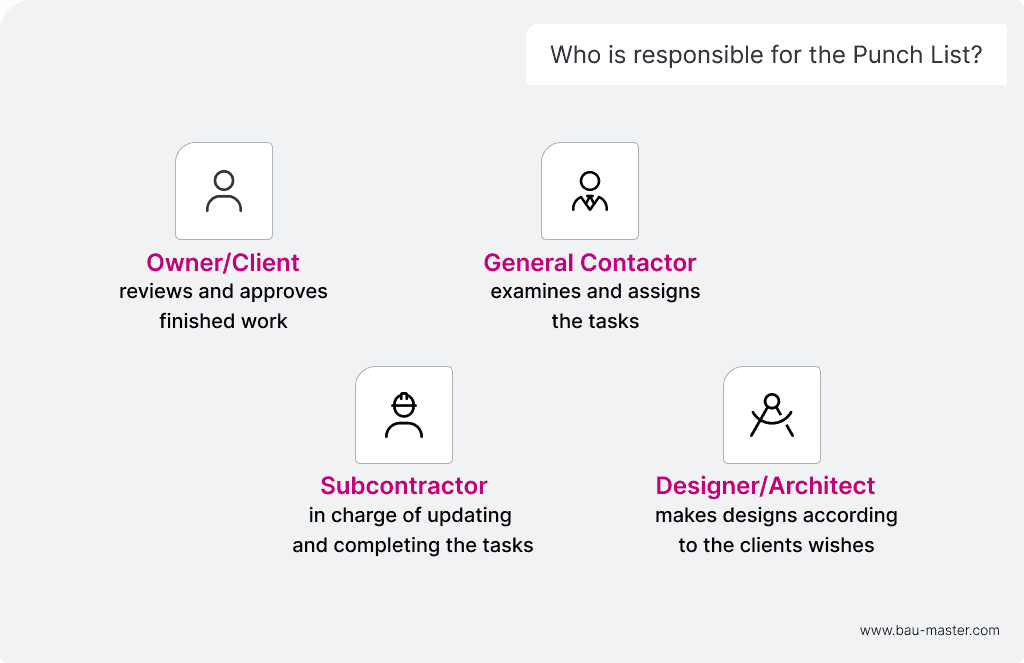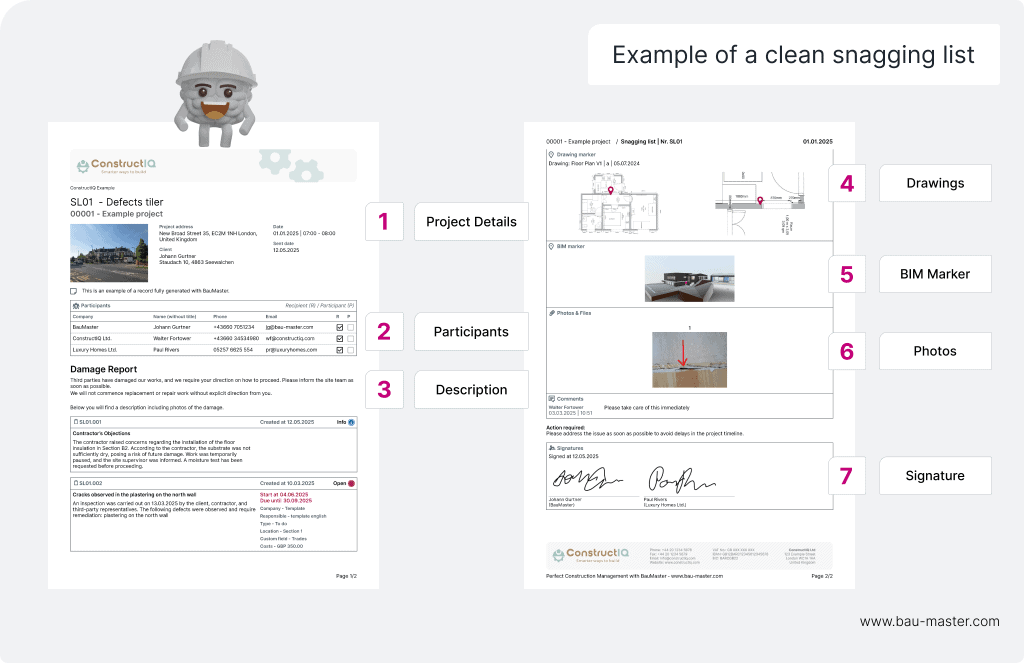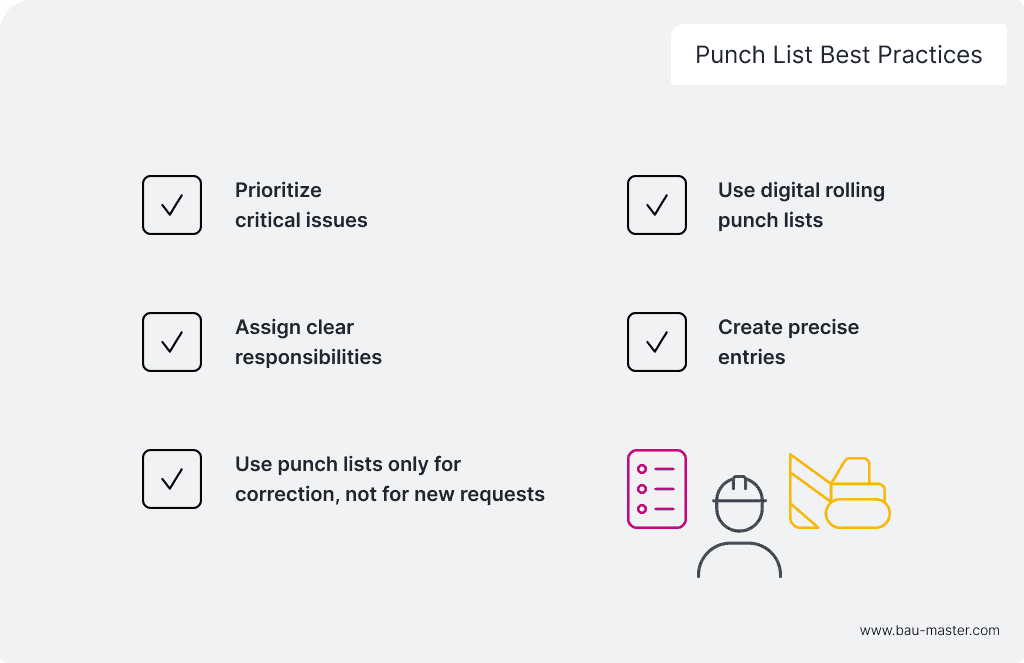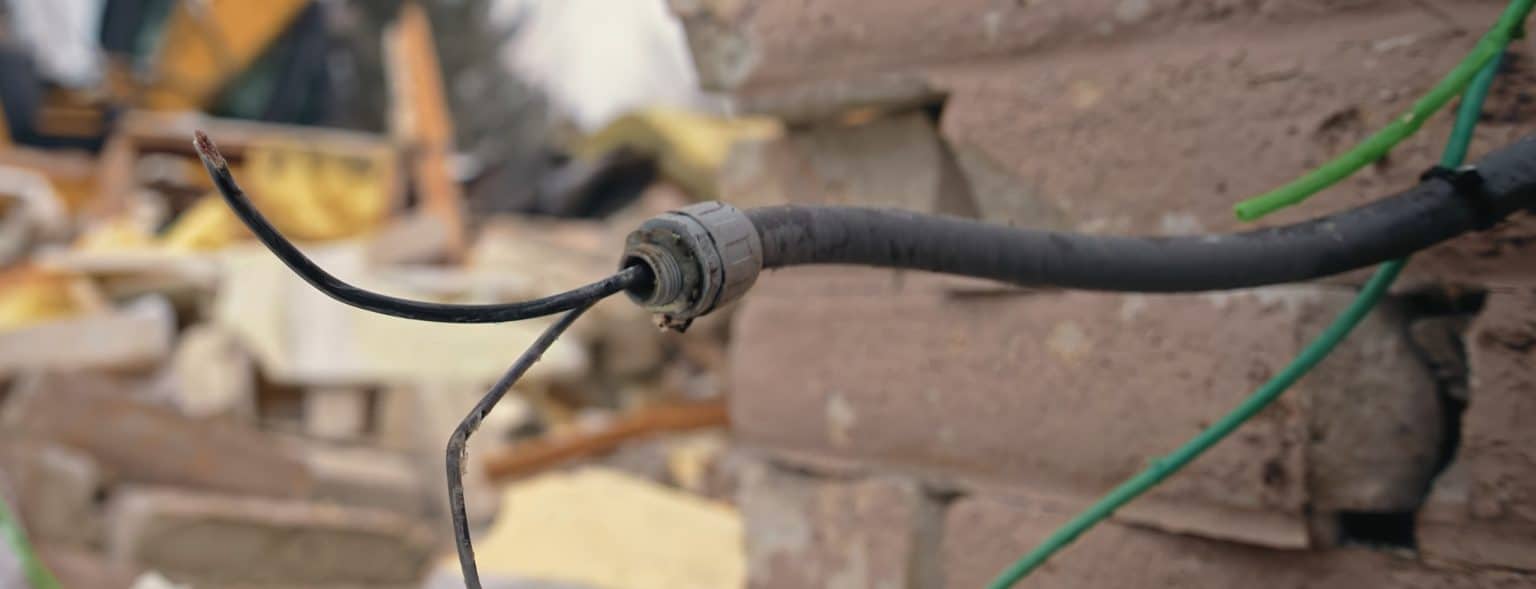Punch lists are an essential part of construction project management, ensuring that “done” means done – with every loose end tied up. They serve as the final quality check before handover, documenting all outstanding tasks, defects, and finishing touches that must be completed to meet contract requirements.
In this guide, you’ll learn what a punch list is, why it matters, when to use it, and how to manage the process effectively.
- What is a punch list in project management?
- What is a punch list in construction?
- The goals of a punch list in construction management
- When should a punch list be created?
- Who is responsible for punch list items?
- Which items does a construction punch list include
- 5 best practices to avoid common punch list problems
- Managing punch lists digitally with BauMaster
- FAQ – Frequently asked questions on punch lists
Construction punch lists at a glance
How to define ‘punch list’: A punch list is the final checklist of defects, incomplete work, or adjustments that must be resolved before a project is considered complete.
What is the purpose of a punch list? It ensures quality, client satisfaction, and compliance – and is often linked to the release of final payment.
Responsibilities: The general contractor/project manager manages the punch list, subcontractors fix their assigned items, and the owner (and sometimes the architect) verifies completion.
Typical punch list items: Minor repairs (e.g. leaks, cracks), cosmetic fixes (e.g. paint touch-ups), functional tests (e.g. HVAC, fire alarms), and clean-up.
Best practices:
– Be precise and document thoroughly.
– Prioritize safety and functionality before cosmetic details.
– Assign clear responsibilities.
– Do not misuse punch lists as change orders.
– Manage punch lists digitally to capture issues on-site, assign tasks instantly, and track progress in real time.
Create rolling punch lists easily with BauMaster:
Get to know our construction log software
What is a punch list in project management?
A punch list is a document used in project management to detail the remaining work, defects, or adjustments needed before a project can be considered complete. It ensures that all items meet the agreed upon specifications before final acceptance. By assigning responsibility, deadlines, and status to each item, the punch list creates transparency and accountability.
What is a punch list in construction?
In construction, a punch list is the final quality-control document at project closeout. It records minor defects, incomplete tasks, or deviations from drawings – such as missing fittings, paint touch-ups, or fixtures needing adjustment. Contractors and subcontractors use it to resolve these items so the project is contract-compliant and ready for handover.
Punch list vs. snag list
The term punch list is commonly used in the US and international construction, while in the UK and Australia the document is also known as a snag list. The purpose is usually the same: to make sure a project is complete and ready for final payment.
The goals of a punch list in construction management
The purpose of a punch list is to guarantee that a project is truly finished before handover. It is the last layer of quality control, ensuring every outstanding detail is corrected. In construction projects, this means that the building is safe, functional, and in line with the contract specifications.
A well-managed punch list achieves several goals:
When should a punch list be created?
Punch lists are usually created at a stage of substantial completion – when a building is usable but still needs final adjustments. The process typically involves:
- Site inspection: The owner, project manager, and sometimes the architect inspect the site and note issues that don’t match the specifications. Each item is recorded on the punch list.
- Corrections and follow-up: The responsible trades are assigned to resolve their issues.
- Final handover inspection: Once all tasks are completed, a follow-up walkthrough confirms that the project is ready for final sign-off and payment.
Many teams use rolling punch lists, meaning they document and fix defects continuously throughout the project, instead of waiting until the very end. This proactive approach reduces last-minute stress and speeds up closeout.
Since these lists are updated frequently, managing them digitally rather than on paper is far more efficient – allowing teams to capture issues on site, share updates instantly, and avoid versioning problems.
Who is responsible for punch list items?
Managing a construction punch list is a team effort, but roles are clearly defined:
- The owner/client reviews and approves the finished work.
- The general contractor or site manager compiles the punch list, coordinates with all parties, assigns tasks, and ensures everything is completed on time.
- Subcontractors and trades carry out the necessary remedial works, such as plumbing leaks, electrical issues, or paint touch-ups.
- The architect or designer (on larger projects) verifies that the work matches the design and may add design-related corrections to the punch list.
In short, the general contractor or project manager drives the process, but successful completion depends on clear communication and accountability from all parties.

Which items does a construction punch list include
A construction punch list usually contains:

5 best practices to avoid common punch list problems
Creating and managing a punch list can either speed up project closeout – or slow it down if handled poorly. Follow these best practices to avoid common pitfalls:

Create precise punch list entries instead of vague descriptions
Be precise and document thoroughly. Instead of writing “fix window,” specify “realign balcony window frame, unit 302, north side.” Add a photo for clarity. Clear details prevent mistakes and repeated site visits.
Prioritize critical issues
Always resolve safety and functionality issues first. While minor cosmetic flaws such as paint scratches can be fixed after handover, if necessary, essential issues like faulty wiring or misaligned fire doors must be corrected beforehand. This ensures the building is safe and operational, while less urgent details don’t hold up completion or payment.
Assign clear responsibilities
Every punch list item should have a clear deadline and a responsible trade. For example: “repair loose stair railing, carpentry crew, due Friday.” Clear accountability, combined with regular follow-ups, prevents bottlenecks and ensures tasks don’t slip through the cracks.
Use punch lists only for correction, not for new requests
To keep projects on schedule and within budget, it’s important to remind stakeholders that punch lists are strictly for correcting existing work. They should not be used to add last-minute extras. Any additional requests should go through a formal change order process.
Use digital rolling punch lists
The earlier issues are identified and resolved, the smoother the project closeout will be. By keeping a rolling punch list in digital form, you can document and fix defects continuously throughout the build — directly on site, with photo documentation, locations, and clear task assignments.
This keeps everyone updated in real time and avoids last-minute pressure. It’s exactly where specialized tools like BauMaster come in.
Managing punch lists digitally with BauMaster
Paper, Word, or Excel punch lists often cause more problems than they solve: versions get mixed up, photos are hard to match with issues, and trades don’t always see updates in time. A digital system turns the punch list into a living, shared document that updates in real time – keeping everyone aligned.
With BauMaster, punch list management becomes simple and transparent:
By switching to BauMaster, rolling punch lists become effortless to manage. You save time, reduce miscommunication, and deliver projects with confidence – knowing every loose end is tied up and documented.
FAQ – Frequently asked questions on punch lists
What is the difference between a checklist and a punch list?
A checklist is a general planning tool that can be used at any stage of a project. A punch list is specific to project closeout and focuses only on incomplete, incorrect, or defective work that must be corrected before the project is signed off.
Why is it called punch list?
The origin of the term “punch list” isn’t certain, but it most likely stems from the practice of literally punching a hole next to completed items on a paper list – sometimes through duplicate copies so both contractor and architect had matching records. Common synonyms include snag list, deficiency list, and punch-out list.
Do all construction projects require a punch list?
Not every project formally requires a punch list, but in practice, most professional construction contracts include one. On small projects, final fixes may be handled informally, but on larger or higher-value builds, a punch list is standard to ensure transparency and quality.
What happens if punch list items are not completed?
If punch list items remain open, the project cannot be considered fully complete. Owners may withhold final payment or retainage until all tasks are resolved. In some cases, unresolved items can also lead to disputes or warranty claims after handover.










